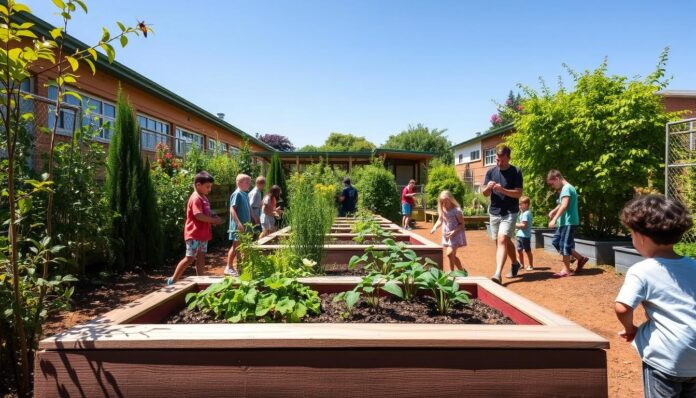Imagine schools teaching a new generation to care for the environment through permaculture. Permaculture school programs can change how students learn about being green. They help schools become eco-friendly places where students can make a difference in the future.
But how do schools start permaculture programs? It’s key to understand the benefits and follow a clear guide. This way, schools can make a big impact on both students and the planet. Together, we can create a better world for all.
Key Takeaways
- Permaculture school programs can increase student engagement and academic performance by 10-20%.
- Permaculture education can lead to a 25% increase in students’ understanding of ecological concepts.
- Schools that adopt permaculture programs can reduce waste production by 30% through composting and recycling initiatives.
- Integrating sustainable practices into school curriculums can result in a 15% reduction in overall operational costs over time.
- Permaculture programs can improve social skills among students engaged in collaborative outdoor projects, with 90% of participating schools reporting positive outcomes.
- Children who participate in outdoor and nature-based learning score an average of 12% higher on standardized tests related to science and environmental awareness.
Understanding Permaculture and Its Importance in Education
Permaculture is a way to make systems sustainable and regenerative. It can be used in many parts of school life. This includes designing curricula, creating outdoor learning spaces, and engaging with the community. By using organic farming curriculum and environmental education, schools can teach about sustainability and social responsibility.
The link to sustainability is key in permaculture. It follows three main ethics: caring for the earth, people, and sharing fairly. Teachers can use these principles to create curricula that support eco-friendly school initiatives and teach about the environment.
Definition of Permaculture
Permaculture is a design system that aims to create sustainable and regenerative systems. It works with nature, not against it.
Connection to Sustainability
The connection to sustainability is vital in permaculture. It focuses on reducing waste and using renewable resources.
Benefits for Students and Communities
Permaculture in education has many benefits. It can make students more engaged, teach them about the environment, and get the community involved. Some benefits include:
- Improved student outcomes
- Enhanced environmental awareness
- Increased community involvement
Assessing School Needs for Permaculture Programs
When starting permaculture programs in schools, it’s key to understand what the school needs. This means finding out what’s missing in the curriculum, talking to everyone involved, and checking what resources are available. By doing a detailed needs assessment, teachers can make permaculture programs that fit their school’s specific needs. This way, they offer hands-on sustainability training and support ecological school programs.
Some important things to think about when looking at school needs include:
- Finding out where permaculture education can fit into the current curriculum
- Talking to teachers, principals, parents, and the community to get their thoughts and support
- Looking at what resources are available, like money, materials, and staff
By taking a thorough approach to understanding school needs, teachers can make permaculture education programs that help the environment. These programs will help make a better future for all of us.
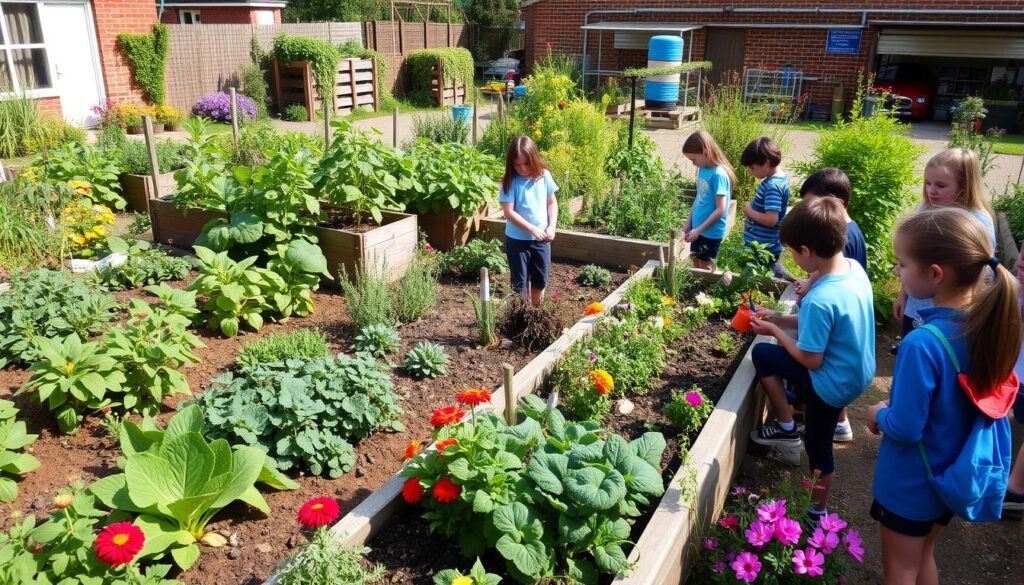
Designing a Permaculture Curriculum
Creating a permaculture curriculum means blending permaculture into school subjects. It’s about making learning fun and relevant for all ages. This way, students grasp the importance of living sustainably and organic farming curriculum.
Hands-on activities like water harvesting and soil building are key. They give students real experience. The curriculum can fit any age, from 3 to 16, and mix with subjects like science and math. For more on permaculture, check out permaculture practice.
For a successful curriculum, schools should team up with local farmers and groups. This brings real-life examples of sustainable living into the classroom. By doing this, schools foster sustainable learning and teach students to care for the environment.
| Age Group | Learning Activities |
|---|---|
| 3-6 years old | Water harvesting, soil building, and nature exploration |
| 7-12 years old | Permaculture design, organic farming, and environmental awareness |
| 13-16 years old | Advanced permaculture design, sustainable living, and community development |
By adding permaculture to school curricula, we can shape a greener future. With the right tools and mindset, permaculture school programs are crucial for teaching sustainable learning and organic farming curriculum.
Developing an Outdoor Learning Space
Outdoor learning spaces are key for eco-friendly school initiatives. They give students hands-on learning about permaculture and sustainability. These areas can be in unused parts of school grounds, like around the oval or in ‘out of bounds’ zones.
When setting up an outdoor learning space, picking the right spot and designing the garden is important. Using native plants helps with hands-on sustainability training and makes learning better. Native plants also help schools promote ecological school programs and boost local wildlife.
Outdoor learning spaces can make students more engaged and motivated. They also help students understand and care for the environment more. Regular outdoor classes can make learning fun and active, without making students too tired.
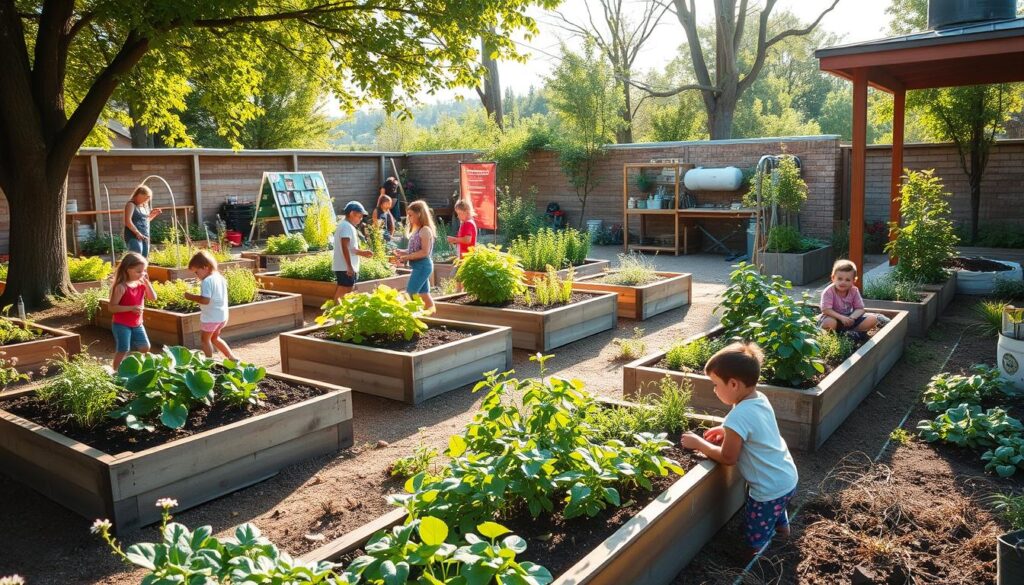
Using permaculture in school gardens can increase local biodiversity by 40%. Outdoor learning spaces also make learning more engaging, with a 50% increase in student interest. Schools with outdoor learning spaces see a 20% rise in student attendance.
Building Community Partnerships
Starting permaculture programs in schools needs strong community ties. This means working with local farmers to give students real-world experience. Schools can then teach both theory and practical skills in organic farming curriculum.
Community partnerships also mean team up with nonprofit groups that back sustainable learning. These groups offer resources, money, and know-how. They help schools keep their permaculture programs going strong.
Establishing Volunteer Opportunities
Volunteer work is key for building community ties. Schools can let students learn from pros and use their skills in real life. This boosts their permaculture education and teaches them to care for their community.
- Developing partnerships with local organizations and businesses
- Creating volunteer programs that align with the school’s permaculture curriculum
- Providing training and support for volunteers
By forming strong community partnerships and offering volunteer chances, schools can give students a full permaculture education. This education prepares them for a green future.
Securing Funding and Resources
To start eco-friendly school projects, you need money and resources. You can find these through grants, crowd-funding, and partnerships. It’s also key to teach students about sustainability hands-on.
Some schools get funding by applying for grants and working with local groups. For instance, the Perennial Corps wants to fund training for people of color in growing perennials. 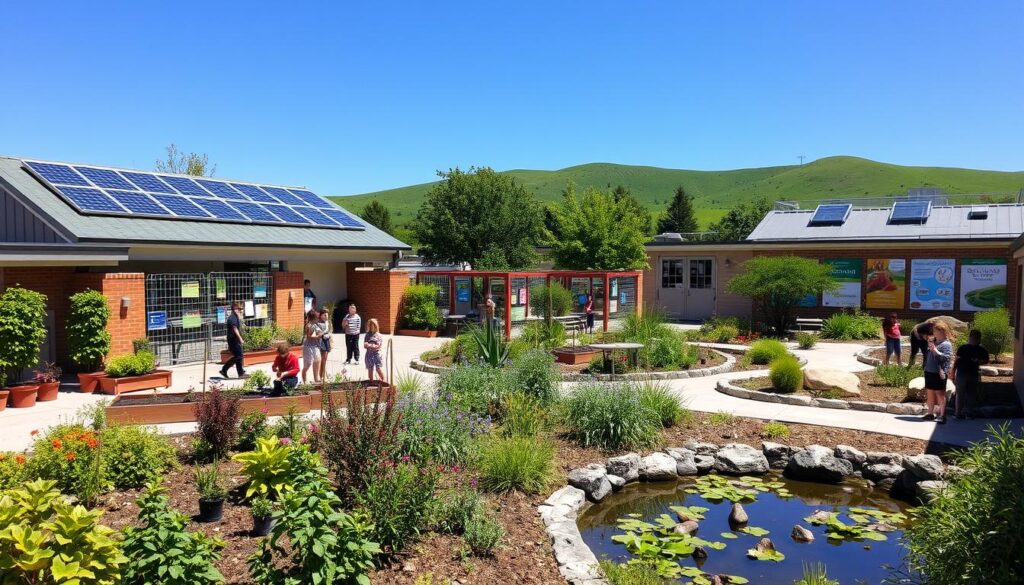
To get funding, schools can:
- Look for and apply to grants for green school projects
- Start crowd-funding campaigns for specific projects
- Partner with local businesses and groups for resources and money
With the right funding and resources, schools can give students what they need for permaculture projects. This supports their learning in sustainability and ecological programs.
Training Educators and Staff
For schools to succeed with permaculture programs, teachers need the right training. They can get this through professional development workshops. These workshops teach sustainable learning and organic farming curriculum. Training teachers is key to teaching permaculture well.
Some important parts of training include:
- Completing a 72-hour Permaculture Design Course (PDC) for teaching certification
- Getting hands-on experience on site
- Working with other teachers and guest-teaching
By offering these chances, schools can make sure teachers know how to use permaculture. This leads to better permaculture school programs and sustainable learning. The cost and time for training vary, but it’s worth it for the benefits.
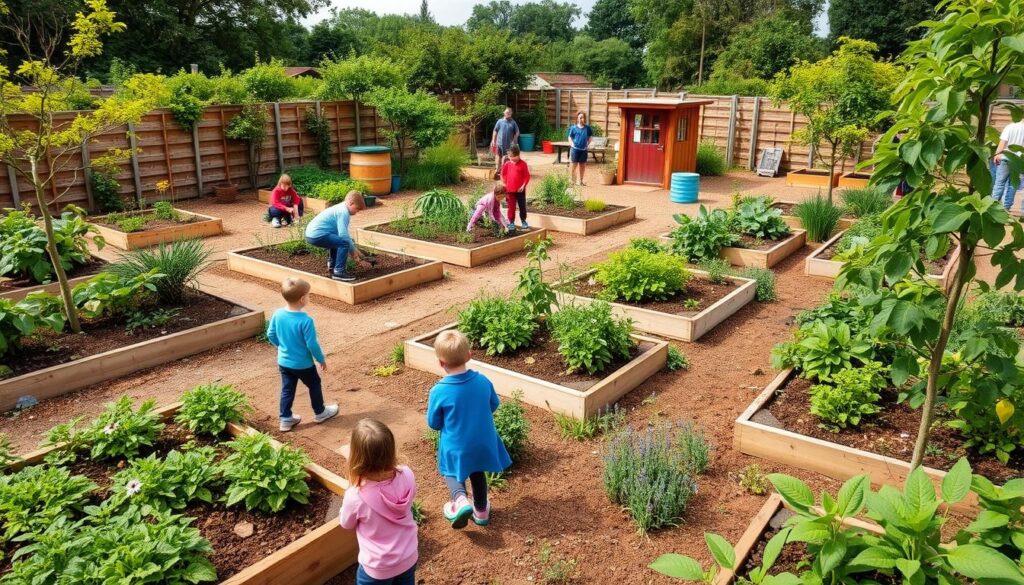
With proper training, teachers can make a big difference. They can teach their students and help the environment. This promotes a culture of sustainable learning and permaculture school programs. Investing in teacher education helps schools succeed in the long run, leading to a greener future.
| Training Aspect | Duration | Cost |
|---|---|---|
| Permaculture Design Course (PDC) | 72 hours | Varies |
| Hands-on site implementation experience | Ongoing | None |
| Co-teaching and guest-teaching experiences | Varies | None |
Implementing the Program Trial
Starting a program trial is key to adding permaculture to schools. It means setting up a test program first. This way, schools can check if it works well and meets everyone’s needs.
Hands-on sustainability training is a big part of this. Students get to do things like gardening and composting. This helps them learn about taking care of the environment.
To see if the trial works, schools ask for feedback. They use surveys, focus groups, or interviews. This helps them improve the program before it’s fully in place. By teaching permaculture, schools help students learn to build green communities.
Here are some important steps for the program trial:
- Start with a pilot program to test and check.
- Get feedback from students to make changes.
- Make sure the trial is a success before it’s a regular part of school.
Evaluating and Adjusting the Program
Starting permaculture school programs means always checking and tweaking them. Schools need to set up ways to get feedback, check how students are doing, and make changes. By using sustainable learning and an organic farming curriculum, students learn a lot about permaculture.
Getting feedback from students, teachers, and the community is crucial. Schools can do this through meetings, surveys, and focus groups. By looking at this feedback, schools can spot what needs work and make smart changes. For example, they can tweak their permaculture school programs to help students do better.
- Establishing clear goals and objectives
- Developing a comprehensive evaluation plan
- Collecting and analyzing data
- Identifying areas for improvement
- Implementing changes and monitoring progress
By using these steps, schools can make sure their permaculture programs work well. They will be fun and give students a great learning experience.
| Strategy | Benefits |
|---|---|
| Establishing clear goals and objectives | Provides direction and focus for the program |
| Developing a comprehensive evaluation plan | Enables schools to collect and analyze data effectively |
| Collecting and analyzing data | Helps schools identify areas for improvement and make data-driven decisions |
Promoting Permaculture Through School Events
It’s important for schools to focus on eco-friendly initiatives. This helps teach students about sustainability and caring for the environment. Schools can host community garden days, workshops, and showcase student projects. These activities engage students and the community, teaching them to care for the planet.
Hands-on training is key for students to grasp permaculture. Through ecological programs, they connect with nature and learn to live sustainably. For example, a school can hold a permaculture festival. Here, students can share their projects and experiences with everyone.
Here are some ways to promote permaculture in schools:
- Organize community garden days to teach sustainable gardening
- Host workshops to educate students and parents about permaculture
- Showcase student projects to highlight eco-friendly efforts
By adding ecological programs to the curriculum, schools give students a full education. This education includes practical sustainability training. It benefits students and helps build a greener community.
Recent data shows there are about 20 permaculture teaching activities available in many languages. These resources help support eco-friendly school projects. By focusing on permaculture, schools can help raise the next generation of environmental leaders.
| Event | Description |
|---|---|
| Community Garden Days | Engage students and the local community in sustainable gardening practices |
| Informational Workshops | Educate students and parents about the benefits of permaculture |
| Showcasing Student Projects | Demonstrate the impact of eco-friendly school initiatives |
Engaging Parents and Guardians
It’s key to get parents and guardians involved for permaculture programs to succeed. Schools can share the perks of permaculture education. This way, they can spread the word about sustainable learning beyond school.
Communicating Benefits
Permaculture education brings many benefits. It teaches about organic farming curriculum and caring for the environment. By getting parents and guardians involved, schools build a community. They also encourage sustainable learning practices.
Involving Families
Schools can get families involved with workshops, garden days, and events. These activities promote permaculture education. They might also give out gardening tools and tips for home gardens.
By working with parents and guardians, schools can grow a permaculture community. This community can include a parent-teacher group focused on permaculture. Schools can also host events and offer gardening resources for homes.
Building a Lasting Permaculture Culture in Schools
Starting permaculture programs in schools is just the beginning. It’s key to build a lasting culture. This means encouraging student leadership and giving them hands-on sustainability training. This way, they can take charge of permaculture practices.
Creating permaculture clubs is another great step. It helps build a community and supports ecological school programs. These clubs can host events, workshops, and activities. They help spread the word about permaculture’s value.
Strategies for Success
- Provide opportunities for student leadership and decision-making
- Offer permaculture education and training for students, teachers, and parents
- Celebrate achievements and successes to reinforce the importance of permaculture practices
By creating a strong permaculture culture in schools, we prepare future generations. They will have the knowledge, skills, and values for a sustainable world.
Documenting and Sharing Success Stories
Starting permaculture school programs means sharing success stories to get more schools involved. Schools can do this by making case studies, using social media, and talking to local media. This shows how well permaculture works in schools.
Permaculture programs focus on sustainable learning. This lets students learn about organic farming curriculum and use it in real life. By sharing these stories, schools can show how permaculture helps students and the community.
Here are some ways to share success stories:
- Make a permaculture newsletter or blog to highlight student work and achievements.
- Use social media to post updates and photos of permaculture projects.
- Talk to local media to show off the success of permaculture in schools.
Sharing success stories helps promote permaculture school programs. It encourages other schools to start their own programs. This helps create a more sustainable learning environment.
| Program | Objective | Outcome |
|---|---|---|
| Permaculture School Program | Implement sustainable learning practices | Improved student learning outcomes and community engagement |
| Organic Farming Curriculum | Develop skills in organic farming | Increased student participation in permaculture activities |
Expanding the Program Beyond the School
Thepermaculture programstarts strong in the school. Now, it’s time to grow its reach. By working with other schools, sharing knowledge, and building aeco-friendly school initiativesnetwork, it can make a bigger difference.
Engaging with nearby schools is a smart move. They can learn from the program’s successes. Hostinghands-on sustainability trainingworkshops is a great way to share knowledge. This helps build a network of schools dedicated to the environment and sustainability.
Students from different schools can also connect. Organizing regional permaculture conferences or workshops is a good idea. It lets them share ideas, show off projects, and motivate each other. This way, students can become leaders in environmental movements.
The school’s permaculture program is a success story. It shows how eco-friendly practices can change education. By reaching out, sharing resources, and building a network, it can inspire more schools to go green.

